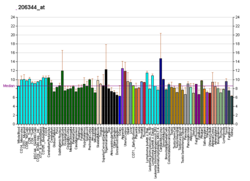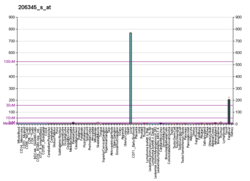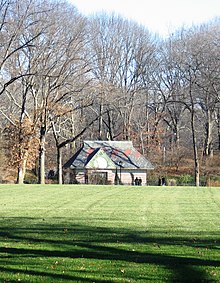PON1
PON1| PON1 | |||||||||||||||||||||||||
|---|---|---|---|---|---|---|---|---|---|---|---|---|---|---|---|---|---|---|---|---|---|---|---|---|---|
 | |||||||||||||||||||||||||
| |||||||||||||||||||||||||
| 식별자 | |||||||||||||||||||||||||
| 에일리어스 | PON1, ESA, MVCD5, PON, 파라옥소나아제1 | ||||||||||||||||||||||||
| 외부 ID | MGI: 103295 HomoloGene: 68058 GeneCard: PON1 | ||||||||||||||||||||||||
| |||||||||||||||||||||||||
| |||||||||||||||||||||||||
| |||||||||||||||||||||||||
| |||||||||||||||||||||||||
| 맞춤법 | |||||||||||||||||||||||||
| 종. | 인간 | 마우스 | |||||||||||||||||||||||
| 엔트레즈 | |||||||||||||||||||||||||
| 앙상블 | |||||||||||||||||||||||||
| 유니프로트 | |||||||||||||||||||||||||
| RefSeq(mRNA) | |||||||||||||||||||||||||
| RefSeq(단백질) | |||||||||||||||||||||||||
| 장소(UCSC) | Chr 7: 95.3 ~95.32 Mb | Chr 6: 5.17~5.19 Mb | |||||||||||||||||||||||
| PubMed 검색 | [3] | [4] | |||||||||||||||||||||||
| 위키데이터 | |||||||||||||||||||||||||
| |||||||||||||||||||||||||
A에스테라아제, 호모시스테인티올락토나아제 또는 혈청아릴디알킬포스파타아제1로도 알려진 혈청파라옥소나아제1(PON1)은 PON1 [5]유전자에 의해 인체 내에서 코드되는 효소이다.파라옥소나아제1은 에스테라아제, 보다 구체적으로는 파라옥소나아제 [6]활성을 가진다.PON1은 염색체 7에 서로 인접한 유전자인 PON2와 PON3를 포함한 다인종 패밀리 중 최초로 발견된 구성원이다.
구조.
인간 PON1은 354개의 아미노산으로 이루어진 당단백질이며, 43000 Daltons의 분자량을 가지고 있으며, 이는 순환 중 고밀도 리포단백질(HDL, 콜레스테롤)과 관련이 있다.혈청 PON1은 간에서 주로 분비되지만, 국소 합성은 여러 조직에서 일어나고 PON1 단백질은 거의 모든 조직에서 발견된다.X선 결정학에서 PON1의 구조는 HDL과 [7][8][9]연관될 수 있는 활성 부위 통로를 덮는 독특한 뚜껑 구조를 가진 6 블레이드 프로펠러임이 밝혀졌다.
기능.
PON1은 유기인산염 살충제와 신경가스를 가수분해하는 역할을 한다.PON1 유전자의 다형성은 [10]효소의 촉매 능력에 유의한 영향을 미친다.
또한 PON1(파라옥소나아제1)은 고밀도 리포단백질([11][12]HDL)의 주요 항아테롬성 동맥경화 성분이다.PON1 유전자는 PPAR-γ에 의해 활성화되어 간에서 파라옥소나아제1효소의 합성과 방출을 증가시켜 아테롬성 동맥경화를 감소시킨다.[13]
PON1의 "자연" 기질은 [14]락톤으로 보인다.그러나 PON1은 락톤(스타틴과 같은 많은 중요한 제약제제 포함), 글루쿠로니드 약물, 티오락톤, 아릴에스테르, 고리형 탄산염, 유기인 살충제 및 사린, 소만 및 VX, 에스트로겐과 같은 신경가스와 같은 다양한 기질을 가수분해할 수 있는 고도로 문란한 효소로 진화했다.에스테르 및 지질 과산화물(고화 지질).
유전학
인간의 PON1은 염색체 [15]7의 장팔에 위치한 PON1 유전자에 의해 부호화된다.PON1의 많은 영양, 생활 양식 및 약학적 조절 인자가 알려져 있지만,[16][17] 개인마다 40배 이상 차이가 날 수 있는 PON1 활성 수준에 대한 가장 큰 영향은 PON1 유전자 다형성을 [8]통해서이다.부호화 영역 PON1-Q192R 다형은 활성에 대한 기판 의존 효과를 결정한다.파라옥손과 같은 일부 기질은 R- 이소폼에 의해 보다 빠르게 가수분해되는 반면 디아독손과 지질-페록시드와 같은 다른 기질은 Q- [8]이소폼에 의해 보다 빠르게 가수분해된다.부호화 영역 PON1-L55M 및 프로모터 영역 PON1-T-108C 다형성은 모두 다른 혈청 농도와 관련지어 활성을 가진다.55L 대립 유전자는 55M 대립 [16][17]유전자에 비해 상당히 높은 PON1 mRNA 및 혈청 단백질 수치를 나타내므로 활성을 보인다.-108C 대립 유전자는 다른 혈청 활성을 유발하는 -108T 대립 유전자에 비해 프로모터 활성이 [16][17]크다.
PON1 다형의 분포는 민족성에 따라 다릅니다.PON1-192R 대립 유전자의 빈도는 유럽에서 더 늘어날수록 증가하며, 백인의 빈도는 극동 동양인과 사하라 이남 아프리카 [18]인구에서 15-30%에서 70-90%로 증가한다.미국 남부에서 흑인들은 [19]백인들보다 RR이 될 확률이 5배나 높다.반면, PON1-55M 대립 유전자는 백인에 비해 동양과 흑인 아프리카 인구에서 훨씬 덜 발생하며, 일부 인구에서는 매우 드물거나 존재하지 않는다.태국인. SNP 분포의 이러한 인종적 차이는 [18]인구 간의 큰 활동 차이를 초래할 수 있습니다.
임상적 의의
PON1은 농약과 신경가스로 널리 사용되는 유기인 화합물을 가수분해하여 해독하는 능력을 통해 처음 발견되었다.수십 년간의 연구에도 불구하고, PON1이 이러한 [20][21]화합물의 급성 및 만성적인 유해 영향으로부터 인간을 보호한다는 것은 이제서야 분명해지고 있다.소아에게서 발견되는 낮은 PON1 활성은 유기인산에 대한 그들의 민감성을 증가시킬 수 있다.
PON1의 아테롬성 동맥 경화증엔, 그것의 능력은 해로운 oxidised-lipids을 제거하기 때문에, PON1 atherosclerosis[22]산화제의 개발에 반대하는 PON는 기질 polyunsaturated 지방산( 그슬린 저밀도 리포 단백질에서)형태lactone-like 구조를 보호한다 하지만, 가장 큰 흥미를 갖고 있는 연구는 역할.[23]
또한 PON1은 그램 음성세균이 인체조직을 침범하여 집락을 형성하게 하는 세균신호분자를 파괴하여 세균감염으로부터 보호하므로 PON1은 신체 선천적 [24]면역에 기여한다.
최근에는 PON1이 건강한 에이징에 관여하는 것이 제안되고 있습니다만, 이 메커니즘은 현재 [25]알려져 있지 않습니다.
PON1의 활성도는 성인에 비해 영아에서 낮다.멕시코계 미국인 아이들을 대상으로 한 연구는 PON1 활동이 출생과 [26]7세 사이에 3.5배 증가했다는 것을 보여주었다.
PON1 유전자 다형과 파킨슨병에 대한 민감성 사이의 연관성은 중국 [27]인구에서 발견되지 않았다.
메모들
이 기사의 2015년 버전은 외부 전문가에 의해 이중 출판 모델로 업데이트되었다.대응하는 학술 동료 리뷰 기사는 Gene에 게재되었으며 다음과 같이 인용할 수 있다. Mike Mackness; Bharti Mackness (1 August 2015). "Human paraoxonase-1 (PON1): Gene structure and expression, promiscuous activities and multiple physiological roles". Gene. Gene Wiki Review Series. 567 (1): 12–21. doi:10.1016/J.GENE.2015.04.088. ISSN 0378-1119. PMC 4458450. PMID 25965560. Wikidata Q28395898. |
레퍼런스
- ^ a b c GRCh38: 앙상블 릴리즈 89: ENSG00000005421 - 앙상블, 2017년 5월
- ^ a b c GRCm38: 앙상블 릴리즈 89: ENSMUSG00000002588 - 앙상블, 2017년 5월
- ^ "Human PubMed Reference:". National Center for Biotechnology Information, U.S. National Library of Medicine.
- ^ "Mouse PubMed Reference:". National Center for Biotechnology Information, U.S. National Library of Medicine.
- ^ Primo-Parmo SL, Sorenson RC, Teiber J, La Du BN (May 1996). "The human serum paraoxonase/arylesterase gene (PON1) is one member of a multigene family". Genomics. 33 (3): 498–507. doi:10.1006/geno.1996.0225. PMID 8661009.
- ^ van Himbergen TM, van Tits LJ, Roest M, Stalenhoef AF (Feb 2006). "The story of PON1: how an organophosphate-hydrolysing enzyme is becoming a player in cardiovascular medicine". The Netherlands Journal of Medicine. 64 (2): 34–8. PMID 16517986.
- ^ Harel M, Aharoni A, Gaidukov L, Brumshtein B, Khersonsky O, Meged R, Dvir H, Ravelli RB, McCarthy A, Toker L, Silman I, Sussman JL, Tawfik DS (May 2004). "Structure and evolution of the serum paraoxonase family of detoxifying and anti-atherosclerotic enzymes". Nature Structural & Molecular Biology. 11 (5): 412–9. doi:10.1038/nsmb767. PMID 15098021. S2CID 52874893.
- ^ a b c Mackness B, Durrington PN, Mackness MI (Sep 1998). "Human serum paraoxonase". General Pharmacology. 31 (3): 329–36. doi:10.1016/s0306-3623(98)00028-7. PMID 9703197.
- ^ Deakin SP, James RW (Nov 2004). "Genetic and environmental factors modulating serum concentrations and activities of the antioxidant enzyme paraoxonase-1". Clinical Science. 107 (5): 435–47. doi:10.1042/CS20040187. PMID 15265000. S2CID 18754293.
- ^ Costa LG, Cole TB, Vitalone A, Furlong CE (Feb 2005). "Measurement of paraoxonase (PON1) status as a potential biomarker of susceptibility to organophosphate toxicity". Clinica Chimica Acta; International Journal of Clinical Chemistry. 352 (1–2): 37–47. doi:10.1016/j.cccn.2004.09.019. PMID 15653099.
- ^ Getz GS, Reardon CA (Jun 2004). "Paraoxonase, a cardioprotective enzyme: continuing issues". Current Opinion in Lipidology. 15 (3): 261–7. doi:10.1097/00041433-200406000-00005. PMID 15166781. S2CID 23497678.
- ^ Mackness M, Mackness B (Nov 2004). "Paraoxonase 1 and atherosclerosis: is the gene or the protein more important?". Free Radical Biology & Medicine. 37 (9): 1317–23. doi:10.1016/j.freeradbiomed.2004.07.034. PMID 15454272.
- ^ Khateeb J, Gantman A, Kreitenberg AJ, Aviram M, Fuhrman B (Jan 2010). "Paraoxonase 1 (PON1) expression in hepatocytes is upregulated by pomegranate polyphenols: a role for PPAR-gamma pathway". Atherosclerosis. 208 (1): 119–25. doi:10.1016/j.atherosclerosis.2009.08.051. PMID 19783251.
- ^ Khersonsky O, Tawfik DS (Apr 2005). "Structure-reactivity studies of serum paraoxonase PON1 suggest that its native activity is lactonase". Biochemistry. 44 (16): 6371–82. doi:10.1021/bi047440d. PMID 15835926.
- ^ Clendenning JB, Humbert R, Green ED, Wood C, Traver D, Furlong CE (Aug 1996). "Structural organization of the human PON1 gene". Genomics. 35 (3): 586–9. doi:10.1006/geno.1996.0401. PMID 8812495.
- ^ a b c Costa LG, Vitalone A, Cole TB, Furlong CE (Feb 2005). "Modulation of paraoxonase (PON1) activity". Biochemical Pharmacology. 69 (4): 541–50. doi:10.1016/j.bcp.2004.08.027. PMID 15670573.
- ^ a b c Schrader C, Graeser AC, Huebbe P, Wagner AE, Rimbach G (Feb 2012). "Allyl isothiocyanate as a potential inducer of paraoxonase-1--studies in cultured hepatocytes and in mice". IUBMB Life. 64 (2): 162–8. doi:10.1002/iub.587. PMID 22131196. S2CID 26735383.
- ^ a b La Du B (1992). "Human serum paraoxonase/arylesterase". In Kalow W (ed.). Pharmacogenetics of Drug Metabolism. New York: Pergamon Press. pp. 51–91.
- ^ McDaniel CY, Dail MB, Wills RW, Chambers HW, Chambers JE (Dec 2014). "Paraoxonase 1 polymorphisms within a Mississippi USA population as possible biomarkers of enzyme activities associated with disease susceptibility". Biochemical Genetics. 52 (11–12): 509–23. doi:10.1007/s10528-014-9663-8. PMID 25027835. S2CID 16649798.
- ^ Costa LG, Giordano G, Cole TB, Marsillach J, Furlong CE (May 2013). "Paraoxonase 1 (PON1) as a genetic determinant of susceptibility to organophosphate toxicity". Toxicology. 307: 115–22. doi:10.1016/j.tox.2012.07.011. PMC 3516631. PMID 22884923.
- ^ Mackness M, Mackness B (2014). "Current aspects of paraoxonase-1 research". In Komoda T (ed.). The HDL handbook : biological functions and clinical implications (Second ed.). Amsterdam: Academic Press. ISBN 978-0-12-407867-3.
- ^ Costa LG, Cole TB, Jarvik GP, Furlong CE (2003). "Functional genomic of the paraoxonase (PON1) polymorphisms: effects on pesticide sensitivity, cardiovascular disease, and drug metabolism". Annual Review of Medicine. 54: 371–92. doi:10.1146/annurev.med.54.101601.152421. PMID 12525679.
- ^ Chistiakov DA, Melnichenko AA, Orekhov AN, Bobryshev YV (2017). "Paraoxonase and atherosclerosis-related cardiovascular diseases". Biochimie. 132: 19–27. doi:10.1016/j.biochi.2016.10.010. PMID 27771368.
- ^ Camps J, Pujol I, Ballester F, Joven J, Simó JM (Apr 2011). "Paraoxonases as potential antibiofilm agents: their relationship with quorum-sensing signals in Gram-negative bacteria". Antimicrobial Agents and Chemotherapy. 55 (4): 1325–31. doi:10.1128/AAC.01502-10. PMC 3067127. PMID 21199929.
- ^ Lee YS, Park CO, Noh JY, Jin S, Lee NR, Noh S, Lee JH, Lee KH (Sep 2012). "Knockdown of paraoxonase 1 expression influences the ageing of human dermal microvascular endothelial cells". Experimental Dermatology. 21 (9): 682–7. doi:10.1111/j.1600-0625.2012.01555.x. PMID 22897574. S2CID 12440057.
- ^ Huen K, Harley K, Bradman A, Eskenazi B, Holland N (Apr 2010). "Longitudinal changes in PON1 enzymatic activities in Mexican-American mothers and children with different genotypes and haplotypes". Toxicology and Applied Pharmacology. 244 (2): 181–9. doi:10.1016/j.taap.2009.12.031. PMC 2846980. PMID 20045427.
- ^ Wang J, Liu Z (Nov 2000). "No association between paraoxonase 1 (PON1) gene polymorphisms and susceptibility to Parkinson's disease in a Chinese population". Movement Disorders. 15 (6): 1265–7. doi:10.1002/1531-8257(200011)15:6<1265::AID-MDS1034>3.0.CO;2-0. PMID 11104219.
추가 정보
- Furlong CE, Costa LG, Hassett C, Richter RJ, Sundstrom JA, Adler DA, Disteche CM, Omiecinski CJ, Chapline C, Crabb JW (Jun 1993). "Human and rabbit paraoxonases: purification, cloning, sequencing, mapping and role of polymorphism in organophosphate detoxification". Chemico-Biological Interactions. 87 (1–3): 35–48. doi:10.1016/0009-2797(93)90023-R. PMID 8393745.
- Furlong CE, Cole TB, Jarvik GP, Costa LG (May 2002). "Pharmacogenomic considerations of the paraoxonase polymorphisms". Pharmacogenomics. 3 (3): 341–8. doi:10.1517/14622416.3.3.341. PMID 12052142.
- Mackness B, Durrington PN, Mackness MI (Aug 2002). "The paraoxonase gene family and coronary heart disease". Current Opinion in Lipidology. 13 (4): 357–62. doi:10.1097/00041433-200208000-00002. PMID 12151850. S2CID 22912885.
- Costa LG, Cole TB, Furlong CE (2003). "Polymorphisms of paraoxonase (PON1) and their significance in clinical toxicology of organophosphates". Journal of Toxicology. Clinical Toxicology. 41 (1): 37–45. doi:10.1081/CLT-120018269. PMID 12645966. S2CID 46233526.
- Furlong CE, Cole TB, Jarvik GP, Pettan-Brewer C, Geiss GK, Richter RJ, Shih DM, Tward AD, Lusis AJ, Costa LG (Aug 2005). "Role of paraoxonase (PON1) status in pesticide sensitivity: genetic and temporal determinants". Neurotoxicology. 26 (4): 651–9. doi:10.1016/j.neuro.2004.08.002. PMID 16112327.








